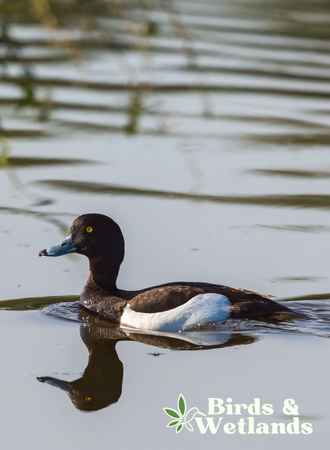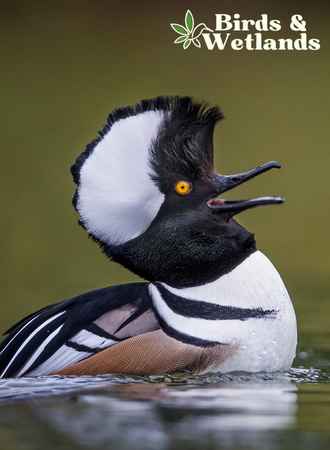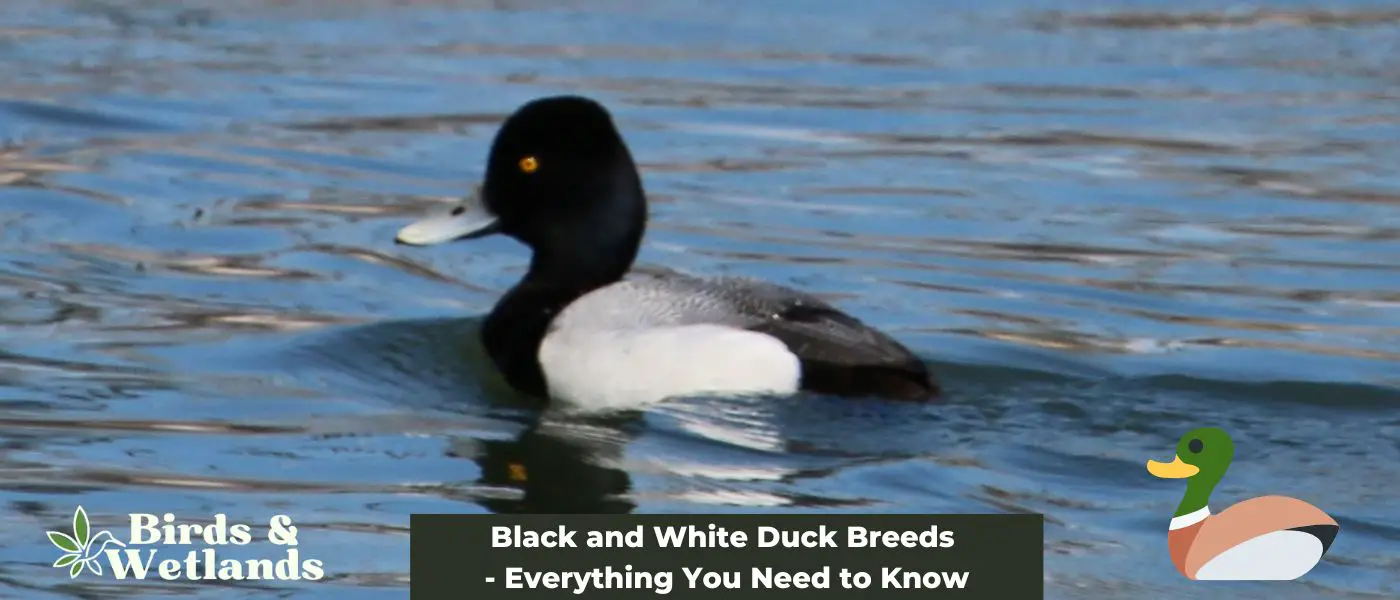You can find many different types of ducks around the world. While some ducks are bred in captivity, others are considered wild and live in more rural areas.
There are a few specific breeds of ducks that are categorized as white or black ducks. Here, we will look at these breeds and what makes them unique.
We will also provide useful information on where to find these ducks and how to care for them. So, if you’re interested in learning more about duck breeds, keep reading!
Key Takeaways on Black and White Duck Breeds
The most common black and white duck breeds include greater scaup, buffleheads, crested duck, tufted duck, magpie ducks, white-winged scoters, ancona ducks, hooded mergansers, common goldeneyes, Pomeranian ducks and Muscovy duck.
Ducks with a mix of black and white feathers are eye-catching and more common than most people might think.
When choosing a duck breed for your backyard or farm, don’t only consider the appearance of the ducks but also their nesting habits, diets and level of aggressiveness toward other animals.
What Are Some of the Most Popular Black and White Duck Breeds?
Muscovy Ducks

Muscovy ducks have originated from South America but are now considered among the most common duck species found throughout the Americas.
Muscovy Ducks have a distinct appearance, with large black patches, long necks and heavy bodies that make them look like small geese. They have a curved, smooth bill that slopes up to their brow, and their long tails help balance their body length. Male muscovy ducks are larger than female muscovy ducks. Likewise, domesticated Muscovies can be much larger than wild Muscovy ducks.
Muscovy Ducks have black or white plumage, but they also have black feathers on their wings and black tail feathers that they can tuck away for camouflage. These ducks are truly eye-catching, with their bright orange/red bills and shiny black legs.
Muscovy ducks are voracious eaters with a diverse set of food preferences. They enjoy foraging grass, weeds, and other green plants in their natural environment. They will eat anything that moves, including insects, slugs, and snails.
A muscovy duck will happily hunt down small rodents like mice and baby rats if those tasty morsels aren’t readily available in the wild. With such a diverse diet, it’s no surprise that these hardy aquatic birds are popular among farmers and home gardeners.
Pomeranian Ducks
Pomeranian ducks are a unique breed of duck that has a fascinating history. Originating in Pomerania, Germany, they were created through intentional crossbreeding efforts to create a new type of duck that was both hardy and prolific. These ducks share ancestry with some other northern European breeds, including the Shetland ducks and the Swedish Blue ducks.
Pomeranian ducks are a type of domestic duck that is found throughout Northeastern Europe. These birds are commonly found in or around poultries, gardens, and farms, where they thrive in a milder climate and ample food supply. They are most frequently spotted between Sweden and Germany and neighboring countries, such as Denmark and Poland.
The Pomeranian duck is a popular waterfowl with a distinct appearance. These medium-sized ducks are distinguished by their dark bodies and striking white breasts, as well as their dark heads, vibrant green iridescent eyes, and black feet and beaks. Their chunky bodies and heart-shaped shoulders give them a distinct and endearing appearance, making them a favorite among duck enthusiasts.
Greater Scaups
The greater scaup is known for its black and white feathers. This duck lives and breeds in the northern parts of North America, Europe and Asia. Annually, thousands of greater scaups congregate along the Atlantic and Pacific coasts.
Greater scaups are distinguished by a dark, iridescent round head and bluish beaks. They also have black breasts, rump, white flanks, yellow eyes and barred grayish backs.
Males have white bodies with black splotches on their wings. Females have dark brown feathers.
The greater scaups is a large sea duck that likes to feed on aquatic invertebrates like mollusks, insects, crustaceans, aquatic plants, and seeds.
Tufted Ducks

Tufted ducks are migratory birds found in Europe, Africa, and North America. They are native to the Palearctic region but can now be found in many habitats worldwide.
During the breeding season, which lasts from May to August, tufted ducks prefer to stay in places like Norway, the British Isles, and the Faroe Islands.
During the winter, they migrate southward to northern Africa, southern Europe, and Southern Asia. Due to milder winters and climate change, some tufted ducks live in some parts of North America all year.
Tufted ducks are medium-sized waterbirds distinguished by their distinctive tufted heads. The drakes are larger and more colorful than the females, with mostly black plumage and white patches on the underside of their bodies. The male and female tufted ducks have black bills and black and grey feet. They are an eye-catching species found in ponds, lakes, bays, marshes, rivers, and estuaries.
Bufflehead Duck
Bufflehead ducks are the smallest diving ducks in North America. They live near lakes and ponds, but they winter near open coast waters in the southern parts of the continent. These ducks mostly breed in the taiga, aspen parklands and boreal forests in the northern regions of Canada and Alaska.
The adult male bufflehead is white with a black back, a dark head, and a large white patch around the back of its head. Female Buffleheads, on the other hand, have dark brown plumage or bodies with an oval and a white cheek patch.
Bufflehead ducks are voracious eaters who enjoy eating a variety of marine insects. These aquatic birds eat a lot of crustaceans, like freshwater crayfish and marine barnacles.
During the winter, their diet expands to include mollusks, such as snails, which are plentiful in shallow coastal waters at this time of year.
Furthermore, plant material accounts for a small portion of bufflehead duck diets, particularly in the fall when they feed heavily on seeds from aquatic plants such as pondweeds.
Crested Ducks
Crested ducks are a distinct breed of waterfowl named after the tuft of feathers on top of their heads. Crested ducks of all colors, including white, black, and mixed black and white, have this feature.
Crested ducks have been around for over four centuries, despite their recent arrival in the United States. They were first introduced to North America in the mid-1800s and quickly became popular for egg and meat production. Many farmers across the country still raise crested ducks because of their gentle temperaments, quick growth rates, and high egg production.
Magpie Ducks

Magpie ducks are a distinct domestic duck breed distinguished by their distinctive black and white feathers. These ducks have black breast, making them stand out from other breeds.
Magpie ducks are known for their large eggs and striking appearance, making them an excellent choice for farmers or gardeners looking to take advantage of their reproductive abilities.
The magpie duck is a black and white duck breed that also has orange legs and a short tail that makes it easy to spot when flying overhead and yellow bills that contrast with its patterned feathers.
White-Winged Scoter
White-winged Scoter is a medium-sized waterfowl with distinguishing characteristics that sets its appearance apart from other waterfowl. This duck is well-adapted to its aquatic lifestyle, with a thick and sturdy bill, large head, and thick neck.
Furthermore, when viewed from above, their forehead slopes down to the back of their head, giving them a slightly sloping appearance.
Despite being similar in size to other waterfowl species like the American wigeon, the white-winged scoter is distinguished by its long tail.
White-winged Scoters are one of North America’s most common scoter species, breeding in boreal forests across western Canada and northwest Alaska. They typically breed in colonies along lake edges, digging nests in small rock crevices or soil depressions.
During the winter, these ducks congregate in large groups to forage for food on coastal waters, ranging from the Great Lakes to the southern coasts of Canada and across much of the United States.
Ancona Duck
Ancona ducks are medium-sized domestic ducks known for their beautiful black and white feather plumage. They are thought to have originated in either the United Kingdom or the United States in the early 1900s, descended from Huttegem and Indian Runner ducks.
Ancona ducks are stronger than their close relative, the Magpie duck, and weigh 6-6.5 pounds on average. These ducks are striking in appearance, with black markings accenting various parts of their white body, such as the cheeks, face, cap, back, sides, wings, and shoulders. The ancona duck also has a white belly and orange feet.
The American Livestock Breeds Conservancy has moved the conservation status of the Ancona duck from critically endangered to watch in the last few years.
Hooded Mergansers

The hooded merganser is a medium-sized duck that has a more streamlined appearance than other duck breeds. The male has an eye-catching black and white patterned crest that he can raise or lower depending on his mood and the situation.
Furthermore, the male’s body is barred in various colors ranging from black to pale and snowy white, making it one of the most distinctive ducks in North America. Females are slightly smaller than males but have similarly patterned crests and bodies, which is unusual.
Hooded mergansers are magnificent black and white ducks found throughout much of North America. These short-distance migrants spend the winter in areas with favorable temperatures and ice conditions, particularly along the eastern coasts of the United States. They prefer small freshwater ponds, lakes, and rivers during the warmer months, where they thrive due to their preference for abundant emergent aquatic vegetation. They have been observed in larger wetlands, impoundments, flooded timber, and even brackish water bodies.
The hooded merganser’s primary hunting strategy involves diving beneath the water to catch prey, allowing it to feed on a diverse range of aquatic creatures. This bird’s primary food source is fish, but it will also consume aquatic insects and other invertebrates such as crabs or crayfish. Because these wild ducks spend their entire lives in or near water, they are easy prey for a skilled hunter such as the hooded merganser.
Common Goldeneye Duck
The common goldeneye duck is a medium-sized duck with a distinct appearance. They are named after their golden-yellow eyes, which stand out against their dark heads.
Adult males have dark bodies with a glossy greenish hue and a distinct circular white patch beneath the eye.
On the other hand, adult females have brown heads and mostly grey bodies, which contrasts with their bright orange-yellow legs and feet. This distinct coloration distinguishes common goldeneye ducks from other waterfowl species.
The common goldeneye is a diving duck that breeds and winters in the taiga, a dense boreal forest that spans Canada and the northern United States. They can be found from the southernmost reaches of Canada to Scotland, Scandinavia, the Baltic States, and northern Russia.
Common goldeneyes prefer coastal waters or inland waters further north in their wintering range. Large tree cavities found in various types of forests and woodlands, including those created by broken tree limbs and those created by large woodpeckers such as pileated and black woodpeckers, are their natural nesting habitats.
These ducks generally return to these natural nesting sites year after year, but if given the opportunity, they will also use nest boxes.
Wood Ducks
Wood ducks are brightly colored birds with distinct plumage that distinguishes them from other perching ducks.
The drake wood duck has iridescent red, green, and purple feathers with white markings on its neck and back of its head. Its bright red eyes stand out against its vibrant body colors, making it easily identifiable in any setting.
While not as brightly colored as the male, the female wood duck has some iridescence on her tail and wings.
Both adults have a distinctively crested head, with the male having a bold white eyering and the female having a more subtle white throat.
Wood ducks are found throughout the eastern and western United States and parts of southern Canada and Mexico’s west coast. These birds typically nest near water in wooded swamps, marshes, ponds, and creeks, usually in hollow trees or specially-built nest boxes.
However, due to competition for nesting areas with other birds, such as hawks and squirrels, wood ducks may be forced to nest further away from their breeding habitat.
Wood ducks feed on land and water by dabbling or sticking their long necks down into the water’s surface to gather food. These waterfowl eat various foods depending on the season, ranging from fruit and seeds in the summer to earthworms and ants in the winter. They will also graze on land in search of acorns, berries, and other nuts that have fallen to the ground.
Cayuga Duck

Cayuga ducks are medium-sized birds with a long neck, black bill and a large body. The plumage is typically all black, but some individuals may have a few white or gray feathers. The wings’ feathers are iridescent, with beetle-green lights sparkling and shimmering in the sunlight. This makes them appealing and eye-catching, especially when this black duck strutting around in the water or on land.
Ring-Necked Duck
Ring-necked ducks are a distinct-looking waterfowl species distinguished by their distinctive plumage coloration.
Adult males have a glossy black body, a shiny, angular head, and eye-catching white rings around their gray bills. They also have dark gray wings with a distinct white line along the edge of their shoulder and a white breast covered in finely textured feathers.
Females are slightly smaller than males and have darker brown plumage. Their heads are brownish-gray and rounded in shape, and their bills are dark with no distinct light bands as seen in males.
Female ring-necked ducks also have bright blue feet and large, pale eyes surrounded by equally pale white circles.
Ring-necked ducks breed and live in forested lakes and ponds in the northern United States and Canada. Their breeding habitat is primarily in these regions’ boreal forests, with smaller breeding populations also found in Canada’s eastern boreal region.
In the winter, ring-necked ducks fly to the southern parts of North America and congregate near lakes, ponds, rivers, or bays.
Ring-necked ducks form pairs during spring migration and begin looking for suitable nesting sites. These birds prefer nesting near shallow ponds or lakes among dense vegetation such as sedges and woody plants.

Jim Addison is an avid bird watcher and has been obsessed with the activity since he was a young boy.
He has traveled all over North America in search of new and interesting species to observe, and his detailed knowledge of the subject makes him a sought-after expert on the topic.


